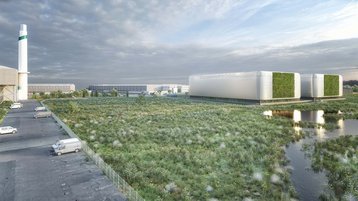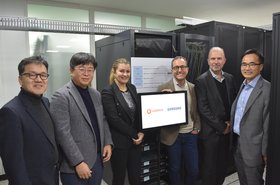Stratus Data Centres is hoping to build two 18MW Tier III data centers on a brownfield site at Belvedere, South East London, according to information published by the projects' architects.
The site is part of Riverside Energy Park, a development by waste management firm Cory, which plans to include the data center on a six-acre site alongside an expanded waste-from energy facility that would handle two million tons of London's unrecyclable waste, and generate something like 45MW of power. Stratus, which describes itself as a property developer, not an operator, originally announced plans for a 100MW London development in 2020, but is not giving more details until tenants are secured.
Stratus also announced a Frankfurt project at its launch in 2020, but has not given further details of this project either.
No tenants yet
"Our task was to design a campus that will provide two identical 18MW, three-story, Tier III Data Centers on a brownfield site with clean power provided directly from the adjacent riverside waste-to-energy plant," says the architect Scott Brownrigg.
The architect describes the concept as "industrial ‘vessels’ placed in a riverside setting," saying they "might be viewed as critical components on a circuit board or nodes on a network". All the critical components of the data center are above the ground floor in case of floods, and "in response to the site context," has put in "biodiversity features", such as 1,700 sqm of living walls and 2,400 sqm of living roofs.
The project is now somewhat different from Stratus' original promise to build a 100MW data center on the site by 2021, which was announced in 2020 when Stratus launched with a $1 billion plan to build data centers, backed by the Australian-based Cromwell Property Group. Stratus was 50 percent owned by Cromwell, while the other was owned by EXS Capital, funded by other investors.
The Belvedere development had already been proposed before the launch of Stratus, with outline planning permission for a data center going back to July 2016, according to an April 2021 Planning Statement by Cory. Brownrigg's design for two square data centers can be seen in images dating back to at least 2019.
According to Cory's planning statement, the waste management firm was granted permission to build a data center (Use Class B8) in July 2016, along with necessary sub-stations, access, car parking and landscaping on a former borax works. The data center, to be powered directly by RRRF through a private wire, was given detailed approval by Bexley in 2020.
The Riverside proposal also includes new energy from a waste facility to handle 655,000 tonnes of non-recyclable waste, generating "enough electricity to power 140,000 homes," according to Cory. On our back-of-envelope calculations, that amounts to about 45MW of power. The site would also have a solar photovoltaic farm, and battery storage to smooth out generation peaks, along with anaerobic digestion for up to 40,000 tonnes of food and green waste per year, which would generate compressed natural gas, electricity, and fertilizer.
The project has in the past attracted concern from the Crossness Nature Reserve immediately to the south of the proposed development.
Stratus CEO Nigel Clarkson declined to say more about the development, telling DCD: "As we are a private company, we don’t do many press releases, but will do so once we secure an occupier/tenant."
Interestingly, the Belvedere site in Bexley already has a data center neighbor: Iron Mountain has a facility directly East of the existing Cory waste-to-energy plant.
It also has a strong history of waste treatment In 1865, on a site a few yards West, the Victorian Crossness Pumping Station was opened by two Archbishops. The sewage pumping station saved London from devastating outbreaks of cholera, and its steam engines remain an important engineering landmark of London.
The site also has a sewage sludge incinerator today.



